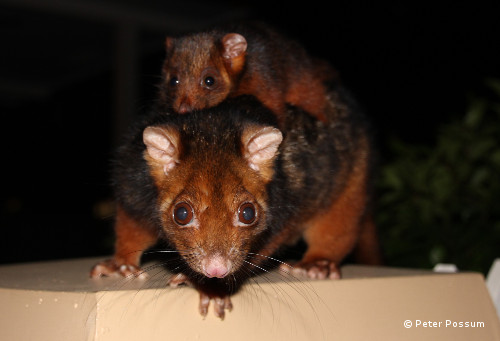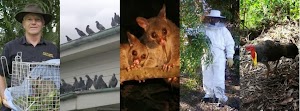Fleas and Parasites of Possums: Peter’s observations: a very low risk in Australia
Over the last ten years, I have never seen parasites on possums around Brisbane.
So it seems there is a lot of false information about the risk of finding fleas and other parasites on possums in Australia. (For lots of useful information on possums, check out our possum FAQ’s) There is one well-known problem: the related Opossum of the Americas is considered one of the reservoirs of animal fleas overseas. They pass parasites on to other animals including humans, cats and dogs. However, they are a very different animal from any of the Australian possums.

Fleas and Parasities
There is one reported case from Taronga zoo of a seriously anaemic ringtail possum (Pseudocheirus peregrinus) being examined. It was found to be infested with stick-fast fleas (Echidnophaga myrmecobii), especially around its ears. The fatal infestation was attributed to a pre-existing injury or illness, which had prevented the possum completing its normal grooming behaviour.
From recent personal correspondence with a major Queensland veterinary hospital that specialises in wildlife, it is suggested about 20% of possums that come into the veterinary hospital carry ticks (mainly cattle ticks and some paralysis ticks, which don’t affect the possum), while approximately 10% carry mites and only 5% are found to have fleas. These are of course animals in distress that need veterinary help, so it is certain that the frequency in the healthy wild population is lower and probably substantially less.
Juvenile possums may become anaemic due to mites, fleas and especially ticks but most adults are not affected, unless they are sick or injured. The animal hospital vets have told me that the numbers are so low that these ectoparasites are not a problem to the hospital staff and are only found from close examination after sedation.
This is very different from the American opossum, which frequently carries a large number of parasites. The fleas feed on the opossum’s blood and then drop off, continue to develop and then pupate. When they sense the movement of a warm animal nearby, they quickly emerge from their cocoon as adults, ready to feed on a new host. Like its Australian cousin, the opossum will live in the roof of houses where they build a nest that becomes infested with their parasites. So they can be a serious problem for humans and removal of a possum nest with its load of parasites from a small cavity in the roof or walls can be difficult and expensive.
That is probably the source of many horror stories about fleas and ticks from “possums.”
It is true that the Brushtail and Ringtail possums of Australia, like all warm-blooded animals, can suffer from parasites. According to publications by the NSW Department of Agriculture, the natural hosts of paralysis ticks are marsupials, particularly bandicoots, as well as echidnas, possums and wallabies. The Dept. of Entomology, University of Sydney also maintains bandicoots are the main natural host of Australian ticks followed by kangaroos, humans and possums. The ticks find a new host animal by climbing to the top of vegetation, waving their legs around and waiting for an animal to pass by. However, the ticks rarely climb more than 50 cm from the ground, so healthy possums cannot be a major target or principal host.







